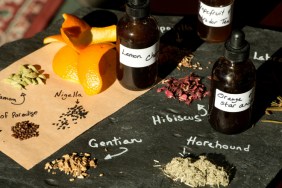
For many people, sake is still a drink shrouded in mystery. By definition, it is a naturally fermented alcoholic beverage made from rice, water, yeast and koji. “It all begins with the rice and then water source,” says Yoshi Yumoto, Vice President and Gekkeikan National Sales Manager.
Originally born and raised in Japan, Yumoto came to the United States and began working for Sidney Frank Importing selling the Gekkeikan Sake line over two decades ago. “I left my steady job in Japan to take a chance in the States doing what I love.” He began with Sidney Frank Importing Company selling sake when it was essentially unknown. Today, Gekkeikan sake sells nearly a half million cases in the US every year.
To make sake, you start with harvesting rice. We aren’t talking typical white rice or Uncle Ben’s. “Sake grade rice is referred to as sakamai.” This rice is a longer grain rice than typical table rice and requires a much more delicate hand when harvesting.
After the rice is harvested, it is delicately polished to get to the rich, starchy center of the kernel that is needed to produce sake. “The style of sake being produced will depend on how much of the original kernel is milled away.” For example to make a Junmai they will mill 30% retaining 70% of the original kernel, 40% for a ginjo and 50% or more for our Daiginjo. “After milling, the rice is allowed to rest for two to three weeks while it rehydrates from the natural humidity in the air because much moisture is lost in the milling process due to heat and friction.” Once the rice reaches evenly balanced moisture content, it is ready for brewing.

Steaming
The rice is then steamed and cooled. “It’s important to note that the rice is not steamed to a point where you would eat it. Rather, it should still be firm on the surface, but the center should be softened to a gelatin like consistency.”
What is Koji?
A portion of the steamed rice is set aside to make what is called koji rice. Koji is what give sake its distinct flavor profile. “Koji-kin is a type of mold spore, of which its enzymes convert starches to simple sugars.” The fermentation of rice wouldn’t be possible without the use of koji because, unlike grapes that have natural sugar, the simple starches in rice need to be converted into sugar.
Fermentation
There’s no naturally occurring sugar in a bilateral fermentation process. “Instead another variant, in the case of sake – koji, is added in to the process to aid in the starch-to-sugar conversion process.” Spores from the koji convert simple starches into glucose. “At the same time, the yeasts are converting the glucose to alcohol.” The term bilateral comes from the fact that both processes happen at the same time in same tank. “Sake is said to be the only alcoholic beverage to be crafted using this type of process.”
Moto
This isn’t a reference to Motorola, it’s a word used to refer to the yeast starter mash that serves as a base for every batch of sake. It’s also often called shubo. “The yeast starter mash is created in a small tank that allows for maximum natural environmental control. It consists of a base mixture of rice, water, koji (progagated koji infected rice), and usually, yeast.”
Moromi
This is another term for the fermentation mash. “After the yeast concentrations are high enough, the shubo or starter mash is moved to a larger tank, at which time, portions of water, koji and rice are added three times over the course of four days, with no addition on the second day.”
Pressing
Once the fermentation process has been completed, the moromi is pressed, removing the rice and leaving behind the sake by product. “There are several different methods for pressing sake.” Most sake is pressed hydraulically using a machine called an Assaku-ki. “The machine squeezes sake in an accordion style machine while catching all of the solids in the slats.” Traditional methods involve gravity and a lot of manpower.
Filtration
After decanting, not dissimilar to vodka, sake is filtered through active charcoal or active carbon to remove anything that will take away from the finished product.
Pasteurization
Sake is a pasteurized product. Most sakes are pasteurized two times prior to shipping.
Maturation
After it’s pasteurized, sake is matured in resting tanks for anywhere between four months and a year depending on the brewmaster’s desired taste.
Second pasteurization
Right before or after bottling, sake is pasteurized for a second time with a heat shower and immediately cooled.

What are the different sake categories?
There are a large number of sake varieties available in the US:
- Junmai – 30% milled rice
- Ginjo – 40% milled rice
- Daiginjo – 50% or more milled rice
- Nigori – coarsely filtered sake leaving behind some rice sediment yielding a much sweeter tasting finished product
- Sparkling – light effervescence. Gekkeikan Zipang achieves is carbonation naturally through a proprietary closed tank fermentation process rather than adding CO2
- Honjozo – when a neutral grain alcohol is added to provide the alcohol content
What’s the best way to drink sake?
A common misconception is that sake is best when imbibed warm. This idea dates back to the post World War II era, when most of America was first introduced to the liquid.
“There are so many varietals of sake available that the best guide to give is to treat it as you would a wine,” says Yumoto. He adds, “Some sakes are best enjoyed warm or at room temperature while others are best enjoyed slightly chilled.”
Yumoto says that it is extremely important to note that sake should never be served ice cold or frozen because it will dull many of the aromatic notes and tropical flavors associated with the liquid. “If you recall the brief description of sake categories, we would suggest Junmai sakes are served either warm or slightly chilled, while ginjos, daiginjos and specialty sakes are all best enjoyed slightly chilled much like most white wines.”








